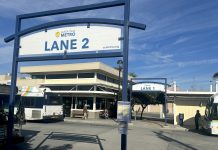
The Santa Cruz County Regional Transportation Commission (RTC) on Aug. 7 had its first discussion about its Zero Emission Passenger Rail and Trail project concept report since it was released to the public on July 30.
But the commissioners agreed that they wanted more information before making any decisions about the controversial rail-trail project, saying they would wait for the final plan to be released in December.
Plans to build a passenger rail line spanning the length of the county have long been controversial, with supporters saying it would be a sound infrastructural investment for the future, and opponents calling it an expensive, impractical boondoggle.
That disagreement came to a head in June, when a preliminary report put the cost estimate for the project at a staggering $4.2 billion, and as much as $41 million a year to operate.
Those numbers are more than four times the estimated costs released in 2022.
The draft report estimates that the passenger train would run every 30 minutes, and could make the cross-county trip in 40-55 minutes, with stops at nine stations. An estimated 4,200-5,400 riders would use the train on weekdays, the report says.
It is still unclear how the county will fund the project, but what seems certain is that residents will be asked to pay for 20%–50% through a sales tax measure starting in 2031, depending on the amount of state and federal funding the RTC is able to secure.
For the 20% scenario, residents would see a 1.5% sales tax increase, along with $345 million in bonds that would last through 2067-68.
The higher 50% scenario would mean a 2.25% sales tax with $900 million in bonds through 2071-72.
Commissioner Steve Clark worried how the increased taxes would affect the senior community living on fixed incomes. He also said that the $4.2 billion price tag for construction is the combined 16-year budget for Scotts Valley, Capitola, Watsonville and Santa Cruz.
“It’s a big lift,” he said. “It’s a lot.”
The numbers—and the estimated $10 one-way ticket price—did not sit well with RTC Commissioner and Santa Cruz County Supervisor Kim De Serpa, who pointed out that people living in rural areas would have to shoulder the cost while not directly benefitting from the train.
“It’s just not affordable for people,” she said. “The costs are staggering and I don’t think they make sense.”
Commissioner Manu Koenig, also a county supervisor, expressed concern that the California Coastal Commission—which has oversight on construction projects near the ocean—will impose unforeseen requirements for the project. This includes possibly ordering the RTC to move the tracks 100 feet inland, and to build a tunnel under La Selva Park.
“These are major infrastructure implications, major cost additions, to this project,” Koenig said. “I think we need to be very clear with the Coastal Commission if they would impose any impacts on this project that would impact our costs in a significant way. They must outline them or we will assume they don’t exist. We need to know from them what they want.”
As part of the final report in December, Koenig also said that he wants to see any added costs, information on constraints on Walker and Beach streets in Watsonville, a financial analysis of cost per-passenger mile compared to other systems and a peer review of the study.
Commissioner Andy Schiffrin had a slightly less bleak view, saying that while the cost is not affordable “at this time,” that could change if outside funding becomes available.
“While it looks from my perspective very bleak in terms of passenger rail at this point, that doesn’t mean it’s always going to be that,” he said.
Schiffrin, who made the motion to delay the discussion to December, said that he wanted to see the final report before moving forward.
Whatever the RTC decides to do, Schiffrin said that South County’s rail system should see improvements.
“No matter what we do on rail, we need to pursue the rail trail segments from Freedom to Watsonville,” he said. “They’re really critical.”
Commissioner Vanessa Quiroz-Carter, who also serves as Watsonville’s mayor and has long supported the rail-trail, asked the RTC to look for other funding sources to help alleviate the tax burden on residents.
“We in Watsonville are completely capped with our taxes, and placing that on Santa Cruz County I think is too much of a burden to shoulder at this time,” she said.
But the train, she said, would be a win for Watsonville residents, particularly those who contend with the daily traffic to and from North County.
“People who commute I think would rather spend 45 minutes in a train or on the bus doing something rather than driving in gridlock 2-mile-per-hour traffic, because it is very exhausting,” she said.
Commissioner Felipe Hernandez said that families who don’t purchase a personal vehicle can save around $1,000 monthly in payments, gas, insurance and maintenance.
“Rail means real economic relief and greater access to jobs, schools, health care across our county and even the region,” he said.
And connecting to rail lines in Monterey County, Hernandez said, would be “transformative for our county.”
“Public transit is one of the most effective investments a community can make,” he said.RTC













How disappointing that the rail consultant misled the commissioners and the public at the RTC meeting by sharing a slide showing the incorrect train travel time of 40-45 minutes instead of the updated estimate of up to 70 minutes. Let’s be real and compare travel time estimates: a 70 minute train ride vs. a 40 minute bus-on-shoulder ride on the highway. The bus project is already underway. Commissioners must stop spending money on perpetual rail project studies.
The costs associated with the report is for the “Cadillac”plan. All We need is a Toyota. It’s ludicrous that those rails are still idle while millions upon millions are spent on trying to accommodate more atmosphere choking, income robbing automobiles. Just as those rails near the Murray St. bridge are sitting while the nearby businesses are choking. A trolley along that route would more than likely bring in much needed dollars, as rail service has always done. The rails there were used for a demonstration of rail service that ran clear into Capitola. It probably could also serve downtown and the Westside, if all parties were willing. Adding stops means increased travel times, as was explained by the consultant. Some stops may not be required at all times of the day.